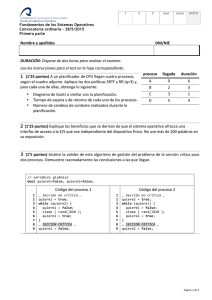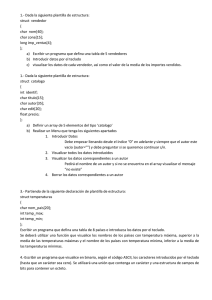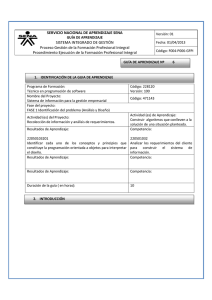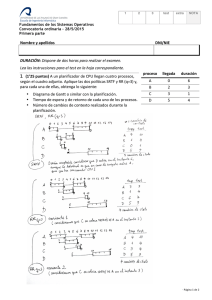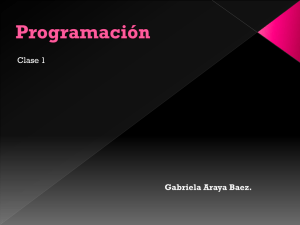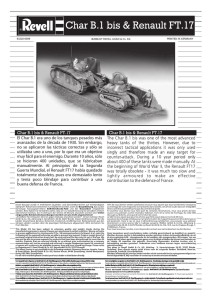Test Case
Anuncio
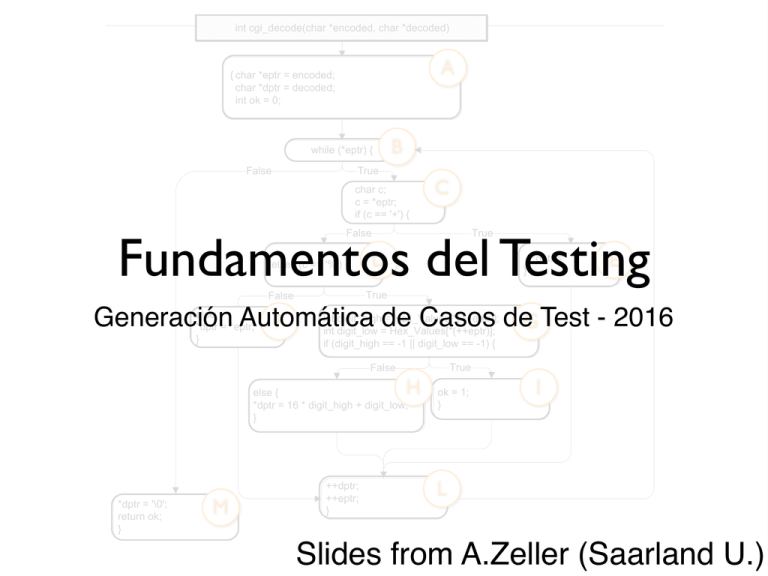
int cgi_decode(char *encoded, char *decoded)
AA
{ char *eptr = encoded;
char *dptr = decoded;
int ok = 0;
while (*eptr) {
False
B
B
True
char c;
c = *eptr;
if (c == '+') {
C
C
Fundamentos del Testing
False
elseif (c == '%') {
True
D
D
*dptr = ' ';
}
E
E
True
False
Generación Automática
de Casos deG Test - 2016
F
else
*dptr = *eptr;
}
F
int digit_high = Hex_Values[*(++eptr)];
int digit_low = Hex_Values[*(++eptr)];
if (digit_high == -1 || digit_low == -1) {
True
False
H
H
else {
*dptr = 16 * digit_high + digit_low;
}
*dptr = '\0';
return ok;
}
MM
++dptr;
++eptr;
}
G
ok = 1;
}
II
L
L
Slides from A.Zeller (Saarland U.)
Ariane V
• Ultimo y más
grande logro del
programa espacial
Europeo
• Vuelo inaugural: 4
de Junio de 1996
wikipedia
Le Bug in Python
Testing read_drift()
#!/usr/bin/env python
!
def read_drift(vertical_bias, horizontal_bias,
vertical_scale = 1.0, horizontal_scale = 1.0):
"""Compute drift as two 16-bit integers (horizontal_drift, vertical_drift)
from vertical_bias/vertical_scale and horizontal_bias/horizontal_scale."""
!
!
!
!
# Vertical drift
vertical_drift_32 = convert_to_32_bit((1.0 / vertical_scale) * vertical_bias)
if vertical_drift_32 > 32767:
vertical_drift_16 = 32767 # 0x7fff
elif vertical_drift_32 < -32768:
vertical_drift_16 = -32768 # 0x8000
else:
vertical_drift_16 = convert_to_16_bit(vertical_drift_32)
import Ariane
!
def test_neutral_scale():
# Fixture
vertical_bias
= 100
horizontal_bias = 200
scale
= 1.0
# Operation
(vertical_drift, horizontal_drift) = \
Ariane.read_drift(vertical_bias,
horizontal_bias, scale, scale)
# Horizontal drift
horizontal_drift_16 = \
convert_to_16_bit((1.0 / horizontal_scale) * horizontal_bias)
return (vertical_drift_16, horizontal_drift_16)
# Check
assert vertical_drift
== vertical_bias
assert horizontal_drift == horizontal_bias
!
Abstraction
Best of Two Worlds
Configurations
Searching for
Best Inputs
Random
Testing
Exhaustive
Testing
Symbolic
Testing
Search-Based
Testing
Del Defecto a la Falla
1. El programador crea un
defecto en el código.
✘
✘
2. Cuando es ejecutado, el
defecto crea una infección.
3. La infección se propaga.
Variables
✘
✘
4. La infección causa una falla.
✘
t
Todos los Errores
•
Error: Una desviación no buscada ni intencional de lo que es
correcto, esperado o verdadero.
•
Defecto: Un error en el código del programa,
específicamente uno que puede crear un infección (y conducir
a una falla)
•
Infección: Un error en el estado del programa,
específicamente uno que puede llevar a una falla
•
Falla: Un error externamente visible en el comportamiento
del programa.
Le Bug
procedure LIRE_DERIVE is
-- lines and parameters omitted
— Compute vertical derivation
L_M_BV_32 := TBD.T_ENTIER_32S ((1.0/C_M_LSB_BV) * G_M_INFO_DERIVE(T_ALG.E_BV));
!
— Convert into 16 bit
if L_M_BV_32 > 32767 then
P_M_DERIVE(T_ALG.E_BV) := 16#7FFF#;
elsif L_M_BV_32 < -32768 then
P_M_DERIVE(T_ALG.E_BV) := 16#8000#;
else
P_M_DERIVE(T_ALG.E_BV) := UC_16S_EN_16NS(TDB.T_ENTIER_16S(L_M_BV_32));
end if;
— Same for horizontal
P_M_DERIVE(T_ALG.E_BH) :=
UC_16S_EN_16NS (TDB.T_ENTIER_16S ((1.0/C_M_LSB_BH) * G_M_INFO_DERIVE(T_ALG.E_BH)));
end LIRE_DERIVE;
— El defecto
L’Effet
•
Una excepción de hardware paralizó el sistema de
inercia referencial así como el sistema backup
(usaban el mismo código), emitiendo información
inválida.
•
Esa información inválida fue interpretada por el
navegador como información válida (no estaba
sanitizada)
•
El Autopilot asumió que se estaba desviando del
curso original, al intentar corregir el cohete salió
del curso previsto y se activó la autodestrucción
— La infección
— La falla
space.com
Testing
• Problema: Una propiedad o
comportamiento del programa
cuestionable.
• Debugging: La actividad de asociar un
problema dado a un defecto que lo causa.
• Testing: La ejecución de un programa con la
intencion de producir algún problema,
especialmente una falla
Objetivos del Testing
•
• Destrucción
• Evaluación
• Prevención
Demonstración
— mostrar que satisface la spec
— tratar de hacerlo fallar
— descubrir si y cómo falla
— evitar futuras fallas
UNIT TESTING
Output
Esperado
=
Input
Programa
1. Ejecutar el programa
Usando datos de test
2. Chequear el output del programa
Usando el oráculo de test
Output
UNIT TESTING
Output
Esperado
≠
Input
Programa
1. Ejecutar el programa
Usando datos de test
2. Chequear el output del programa
Usando el oráculo de test
Output
JUNIT TESTING
@Test
public void test()
{
Input
Programa
Output
Output
Esperado
}
http://junit.org/
JUNIT TESTING
@Test
public void test()
{
Input
// Setup
// Program
Exercise
//
Output
Expected
Check
Output
}
http://junit.org/
JUNIT TESTING
@Test
public void test()
{
int
x = 2;
// Setup
int y = 2;
// Exercise
int result = add(x,y);
//
Check
assertEquals(4,
result);
}
http://junit.org/
ANOTACIONES JUNIT
@Test (timeout=100)
Un test case (posiblemente con un timeout)
@Ignore ("Reason")
No ejecutar este test case
@Before
Ejecutar antes de cada test case
@After
Ejecutar luego de cada test case
@BeforeClass
Ejecutar una única vez antes de todos los test cases
@AfterClass
Ejecutar una única vez luego de todos los test cases
ASERCIONES JUNIT
assertTrue([message], condition);
assertFalse([message], condition);
assertNull([message], object);
assertNotNull([message], object);
assertEquals([message], expected , actual);
assertEquals([message], expected , actual , epsilon);
assert[Not]Same([message], object, object);
ORGANIZANDO TESTS
public class TestMyClass {
@Before public void setup() { … }
@After public void tearDown() { … }
@Test public void test1() { … }
@Test public void test0() { … }
}
TESTING DE
EXCEPCIONES
@Test
public void test() {
try {
foo.bar();
fail(“Expected exception!”);
} catch(Exception e) {
// Expected exception
}
}
TESTING DE
EXCEPCIONES
@Test(expected = Exception.class)
public void test() {
foo.bar();
}
DEMO
Java
Eclipse IDE
http://www.eclipse.org/
JUnit Framework
Los 3 Desafíos del Testing
1. Tenemos que disparar el error en
cuestión:
• ejecutar el defecto
• hacer que la infección se propague, y
• resulte en una falla.
2. Debemos reconocer el error como tal
– como una desviación de lo que es
correcto, válido, o verdadero.
3. Debemos identificar funcionalidad
faltante
✘
Variables
✘
✘
✘
✘
t
Los 3 Desafíos del Testing
1. Tenemos que disparar el error en
cuestión:
• ejecutar el defecto
• hacer que la infección se propague, y
• resulte en una falla.
2. Debemos reconocer el error como tal
– como una desviación de lo que es
correcto, válido, o verdadero.
— Cubrir tanto
comportamiento como
sea posible
— Proveer un oráculo
3. Debemos identificar funcionalidad
faltante
— Tener una especificación
Los 3 Desafíos del Testing
1. Tenemos que disparar el error en
cuestión:
• ejecutar el defecto
• hacer que la infección se propague, y
• resulte en una falla.
2. Debemos reconocer el error como tal
– como una desviación de lo que es
correcto, válido, o verdadero.
3. Debemos identificar funcionalidad
faltante
}
En una forma
eficiente
(realizable)
Los 3 Desafíos del Testing
1. Tenemos que disparar el error en
cuestión:
• ejecutar el defecto
• hacer que la infección se propague, y
• resulte en una falla.
2. Debemos reconocer el error como tal
– como una desviación de lo que es
correcto, válido, o verdadero.
3. Debemos identificar funcionalidad
faltante
— Cubrir tanto
comportamiento como
sea posible
— Proveer un oráculo
— Tener una especificación
Los 3 Desafíos del Testing
1. Tenemos que disparar el error en
cuestión:
• ejecutar el defecto
• hacer que la infección se propague, y
• resulte en una falla
— Cubrir tanto
comportamiento como
sea posible
— Provide an oracle
Qué es exactamente
el
— Have a spec
“comportamiento”?
Los 3 Desafíos del Testing
1. Tenemos que disparar el error en
cuestión:
• ejecutar el defecto
• hacer que la infección se propague, y
• resulte en una falla.
— Provide an oracle
debemos alcanzar cada línea del programa
— Have a spec
Test Cases vs. Test Suites
• Test Case: compuesto por código para
setup, exercise, check
• requiere de alguna noción de oráculo
• Test Suite: un conjunto de test cases
• sin orden necesariamente
Criterios de
Adecuación
• ¿Cómo sabemos que una test suite es
“suficientemente buena”?
• Un criterio de adecuación de test es un
predicade que es verdadero o falso para un par
⟨programa, test suite⟩
• Usualmente expresado en forma de una regla –
e.g., “todos los statements deben ser
ejecutados”
Testing Estructural
public roots(double a, double b, double c)
double q = b * b - 4 * a * c;
•
El control flow graph (CFG) puede
servir como un criterio de
adecuación para test cases
•
Cuanto mas “partes” son
ejecutadas (cubiertas), mayores
las chances de un test de
descubrir una falla
•
“partes” pueden ser: nodos, ejes,
caminos, decisiones…
q > 0 && a != 0
// code for two roots
q == 0
// code for one root
// code for no roots
return
Control Flow Patterns
while (COND)
do
for
BODY
BODY
INIT
while (COND)
BODY;
while (COND)
COND
do {
BODY
if (COND)
BODY
} while (COND);
INCR
THEN-BLOCK
ELSE-BLOCK
if (COND)
THEN-BLOCK;
else
ELSE-BLOCK;
for (INIT; COND; INCR)
BODY;
Statement Testing
• Criterio de Adecuación: cada statement (o
nodo en el CFG) debe ser ejecutado al
menos una vez
• Idea: un defecto en un statement sólo
puede ser revelado ejecutando el defecto
• Cobertura:
# statements ejecutados
# statements
Ejemplo: cgi_decode
/**
* @title cgi_decode * @desc * Translate a string from the CGI encoding to plain ascii text * ’+’ becomes space, %xx becomes byte with hex value xx, * other alphanumeric characters map to themselves *
* returns 0 for success, positive for erroneous input
* 1 = bad hexadecimal digit */
int cgi_decode(char *encoded, char *decoded)
{
char *eptr = encoded;
char *dptr = decoded;
A
int ok = 0;
while (*eptr) /* loop to end of string (‘\0’ character) */
B
{
char c;
C
c = *eptr;
if (c == ’+’) { /* ‘+’ maps to blank */
*dptr = ’ ’; E
} else if (c == ’%’) { /* ’%xx’ is hex for char xx */
D
int digit_high = Hex_Values[*(++eptr)]; int digit_low = Hex_Values[*(++eptr)]; G
if (digit_high == -1 || digit_low == -1)
ok = 1; /* Bad return code */ I
else
*dptr = 16 * digit_high + digit_low; H
} else { /* All other characters map to themselves */
*dptr = *eptr;
F
}
++dptr; ++eptr;
L
}
*dptr = ‘\0’;
return ok;
}
/* Null terminator for string */
M
int cgi_decode(char *encoded, char *decoded)
AA
{ char *eptr = encoded;
char *dptr = decoded;
int ok = 0;
while (*eptr) {
False
B
B
True
char c;
c = *eptr;
if (c == '+') {
C
C
False
elseif (c == '%') {
F
F
D
D
*dptr = ' ';
}
True
False
else
*dptr = *eptr;
}
True
int digit_high = Hex_Values[*(++eptr)];
int digit_low = Hex_Values[*(++eptr)];
if (digit_high == -1 || digit_low == -1) {
True
False
H
H
else {
*dptr = 16 * digit_high + digit_low;
}
*dptr = '\0';
return ok;
}
M
M
++dptr;
++eptr;
}
G
G
ok = 1;
}
L
L
II
E
E
int cgi_decode(char *encoded, char *decoded)
✔
AA
{ char *eptr = encoded;
char *dptr = decoded;
int ok = 0;
while (*eptr) {
False
✔
B
B
True
char c;
c = *eptr;
if (c == '+') {
✔
C
C
False
elseif (c == '%') {
F
✔
F
True
D
✔
D
*dptr = ' ';
}
True
False
else
*dptr = *eptr;
}
int digit_high = Hex_Values[*(++eptr)];
int digit_low = Hex_Values[*(++eptr)];
if (digit_high == -1 || digit_low == -1) {
H
H
else {
*dptr = 16 * digit_high + digit_low;
}
✔
MM
++dptr;
++eptr;
}
G
G
True
False
*dptr = '\0';
return ok;
}
“test”
ok = 1;
}
✔
L
L
II
E
E
int cgi_decode(char *encoded, char *decoded)
✔
AA
{ char *eptr = encoded;
char *dptr = decoded;
int ok = 0;
while (*eptr) {
False
✔
B
B
True
char c;
c = *eptr;
if (c == '+') {
✔
C
C
False
elseif (c == '%') {
F
✔
F
True
D
✔
D
*dptr = ' ';
}
True
False
else
*dptr = *eptr;
}
int digit_high = Hex_Values[*(++eptr)];
int digit_low = Hex_Values[*(++eptr)];
if (digit_high == -1 || digit_low == -1) {
H
H
else {
*dptr = 16 * digit_high + digit_low;
}
✔
MM
++dptr;
++eptr;
}
G
G
True
False
*dptr = '\0';
return ok;
}
“test”
“a+b”
ok = 1;
}
✔
L
L
II
E
✔
E
int cgi_decode(char *encoded, char *decoded)
✔
AA
{ char *eptr = encoded;
char *dptr = decoded;
int ok = 0;
while (*eptr) {
False
✔
B
B
True
char c;
c = *eptr;
if (c == '+') {
✔
C
C
False
elseif (c == '%') {
F
✔
F
True
D
✔
D
*dptr = ' ';
}
True
False
else
*dptr = *eptr;
}
int digit_high = Hex_Values[*(++eptr)];
int digit_low = Hex_Values[*(++eptr)];
if (digit_high == -1 || digit_low == -1) {
✔
H
H
else {
*dptr = 16 * digit_high + digit_low;
}
✔
MM
++dptr;
++eptr;
}
G
✔
G
True
False
*dptr = '\0';
return ok;
}
“test”
“a+b”
“%3d”
ok = 1;
}
✔
L
L
II
E
✔
E
int cgi_decode(char *encoded, char *decoded)
✔
AA
{ char *eptr = encoded;
char *dptr = decoded;
int ok = 0;
while (*eptr) {
False
✔
B
B
True
char c;
c = *eptr;
if (c == '+') {
✔
C
C
False
elseif (c == '%') {
F
✔
F
True
D
✔
D
*dptr = ' ';
}
True
False
else
*dptr = *eptr;
}
int digit_high = Hex_Values[*(++eptr)];
int digit_low = Hex_Values[*(++eptr)];
if (digit_high == -1 || digit_low == -1) {
✔
H
H
else {
*dptr = 16 * digit_high + digit_low;
}
✔
MM
++dptr;
++eptr;
}
G
✔
G
True
False
*dptr = '\0';
return ok;
}
“test”
“a+b”
“%3d”
“%g”
ok = 1;
}
✔
L
L
✔
II
E
✔
E
Statement Testing
• Cobertura:
# statements ejecutados
# statements
int cgi_decode(char *encoded, char *decoded)
✔
AA
{ char *eptr = encoded;
char *dptr = decoded;
int ok = 0;
100
75
while (*eptr) {
False
✔
B
B
True
63
char c;
c = *eptr;
if (c == '+') {
50
✔
C
C
False
elseif (c == '%') {
25
0
Cobertura
F
✔
F
True
D
✔
D
*dptr = ' ';
}
True
False
else
*dptr = *eptr;
}
int digit_high = Hex_Values[*(++eptr)];
int digit_low = Hex_Values[*(++eptr)];
if (digit_high == -1 || digit_low == -1) {
H
✔
MM
++dptr;
++eptr;
}
G
G
True
False
H
else {
*dptr = 16 * digit_high + digit_low;
}
*dptr = '\0';
return ok;
}
“test”
ok = 1;
}
✔
L
L
II
E
E
int cgi_decode(char *encoded, char *decoded)
75
✔
AA
{ char *eptr = encoded;
char *dptr = decoded;
int ok = 0;
100
while (*eptr) {
72
False
✔
B
B
True
char c;
c = *eptr;
if (c == '+') {
50
✔
C
C
False
elseif (c == '%') {
25
0
Cobertura
F
✔
F
True
D
✔
D
*dptr = ' ';
}
True
False
else
*dptr = *eptr;
}
int digit_high = Hex_Values[*(++eptr)];
int digit_low = Hex_Values[*(++eptr)];
if (digit_high == -1 || digit_low == -1) {
H
✔
MM
++dptr;
++eptr;
}
G
G
True
False
H
else {
*dptr = 16 * digit_high + digit_low;
}
*dptr = '\0';
return ok;
}
“test”
“a+b”
ok = 1;
}
✔
L
L
II
E
✔
E
int cgi_decode(char *encoded, char *decoded)
✔
AA
{ char *eptr = encoded;
char *dptr = decoded;
int ok = 0;
100
“test”
“a+b”
“%3d”
91
75
while (*eptr) {
False
✔
B
B
True
char c;
c = *eptr;
if (c == '+') {
50
✔
C
C
False
elseif (c == '%') {
25
0
Cobertura
F
✔
F
D
✔
D
*dptr = ' ';
}
True
False
else
*dptr = *eptr;
}
True
int digit_high = Hex_Values[*(++eptr)];
int digit_low = Hex_Values[*(++eptr)];
if (digit_high == -1 || digit_low == -1) {
True
False
✔
H
H
else {
*dptr = 16 * digit_high + digit_low;
}
*dptr = '\0';
return ok;
}
✔
MM
++dptr;
++eptr;
}
G
✔
G
ok = 1;
}
✔
L
L
II
E
✔
E
int cgi_decode(char *encoded, char *decoded)
100
✔
AA
{ char *eptr = encoded;
char *dptr = decoded;
int ok = 0;
100
75
while (*eptr) {
False
✔
B
B
True
char c;
c = *eptr;
if (c == '+') {
50
✔
C
C
False
elseif (c == '%') {
25
0
Cobertura
F
✔
F
True
D
✔
D
*dptr = ' ';
}
True
False
else
*dptr = *eptr;
}
int digit_high = Hex_Values[*(++eptr)];
int digit_low = Hex_Values[*(++eptr)];
if (digit_high == -1 || digit_low == -1) {
✔
H
✔
MM
++dptr;
++eptr;
}
G
✔
G
True
False
H
else {
*dptr = 16 * digit_high + digit_low;
}
*dptr = '\0';
return ok;
}
“test”
“a+b”
“%3d”
“%g”
ok = 1;
}
✔
L
L
✔
II
E
✔
E
Calculando la Cobertura
•
La Cobertura es computada automáticamente mientras el
programa es ejecutado
•
•
Requiere la instrumentación en tiempo de compilación
Luego de la ejecución, una herramienta de cobertura analiza y
resume los resultados
Demo
Criterios
de Test
Path testing
Boundary
interior testing
Compound
condition testing
Theoretical Criteria
subsumes
LCSAJ testing
Branch and
condition testing
Edge testing
Loop boundary
testing
Statement testing
Basic
condition testing
Practical Criteria
MCDC testing
Criterios
de Test
Path testing
Boundary
interior testing
Compound
condition testing
Theoretical Criteria
subsume
LCSAJ testing
Branch and
condition testing
Edge testing
Loop boundary
testing
Statement testing
Basic
condition testing
Practical Criteria
MCDC testing
Edge Testing
• Criterio de adecuación: cada eje en el CFG
debe ser ejecutado al menos una vez
• Cobertura :
# ejes ejecutados
# ejes
• Subsume Statement Testing
ya que al recorrer todos los ejes recorremos todos los nodos
int cgi_decode(char *encoded, char *decoded)
101
✔
AA
{ char *eptr = encoded;
char *dptr = decoded;
int ok = 0;
100
75.75
while (*eptr) {
False
✔
B
B
True
char c;
c = *eptr;
if (c == '+') {
50.5
✔
C
C
False
elseif (c == '%') {
25.25
0
Line Coverage
F
F
True
D
✔
D
*dptr = ' ';
}
int digit_high = Hex_Values[*(++eptr)];
int digit_low = Hex_Values[*(++eptr)];
if (digit_high == -1 || digit_low == -1) {
✔
H
✔
MM
++dptr;
++eptr;
}
G
✔
G
True
False
H
else {
*dptr = 16 * digit_high + digit_low;
}
*dptr = '\0';
return ok;
}
E
✔
E
True
False
else
*dptr = *eptr;
}
“+%0d+%4j”
ok = 1;
}
✔
II
✔
L
L
Asumamos que F no existe (defecto)
int cgi_decode(char *encoded, char *decoded)
AA
{ char *eptr = encoded;
char *dptr = decoded;
int ok = 0;
while (*eptr) {
False
B
B
True
char c;
c = *eptr;
if (c == '+') {
C
C
False
elseif (c == '%') {
F
F
True
D
D
*dptr = ' ';
}
int digit_high = Hex_Values[*(++eptr)];
int digit_low = Hex_Values[*(++eptr)];
if (digit_high == -1 || digit_low == -1) {
H
H
else {
*dptr = 16 * digit_high + digit_low;
}
*dptr = '\0';
return ok;
}
M
E
++dptr;
++eptr;
}
G
G
True
False
M
E
True
False
else
*dptr = *eptr;
}
“+%0d+%4j”
ok = 1;
}
II
L
L
Asumamos que F no existe (defecto)
int cgi_decode(char *encoded, char *decoded)
AA
{ char *eptr = encoded;
char *dptr = decoded;
int ok = 0;
100
87
75
while (*eptr) {
False
✔
B
B
True
✔
char c;
c = *eptr;
if (c == '+') {
50
C
C
False
✔
elseif (c == '%') {
25
0
Branch Coverage
F
F
True
✔
D
D
*dptr = ' ';
}
int digit_high = Hex_Values[*(++eptr)];
int digit_low = Hex_Values[*(++eptr)];
if (digit_high == -1 || digit_low == -1) {
✔
False
H
*dptr = '\0';
return ok;
}
M
E
++dptr;
++eptr;
}
G
G
True
✔
H
else {
*dptr = 16 * digit_high + digit_low;
}
M
E
✔
True
False
else
*dptr = *eptr;
}
“+%0d+%4j”
ok = 1;
}
II
L
L
Si consideramos los branches, entonces ejercitaríamos el defecto
int cgi_decode(char *encoded, char *decoded)
100
AA
{ char *eptr = encoded;
char *dptr = decoded;
int ok = 0;
100
75
while (*eptr) {
False
✔
B
True
✔
50
C
C
False
✔
elseif (c == '%') {
0
Branch Coverage
F
F
True
✔
D
D
*dptr = ' ';
}
✔
True
False
✔
else
*dptr = *eptr;
}
int digit_high = Hex_Values[*(++eptr)];
int digit_low = Hex_Values[*(++eptr)];
if (digit_high == -1 || digit_low == -1) {
✔
False
H
*dptr = '\0';
return ok;
}
M
++dptr;
++eptr;
}
G
G
True
✔
H
else {
*dptr = 16 * digit_high + digit_low;
}
M
“abc”
B
char c;
c = *eptr;
if (c == '+') {
25
“+%0d+%4j”
ok = 1;
}
L
L
II
E
E
Branch Testing
•
Criterio de adecuación: cada branch en el CFG
debe ser ejecutado al menos una vez
•
Cobertura : # branches ejecutados
# branches
•
No Subsume Statement Testing ni Edge Testing
puedo ejercitar todos los branches y no cubrir
todos los ejes/nodos
•
Mas comúnmente usado en la Industria
Taller - Parte 1
• Cobertura en JUnit
• Escribir un test suite JUnit Test con 100%
branch/statemente coverage en la clase
org.autotest.StackAr
